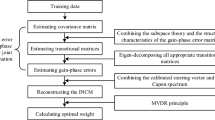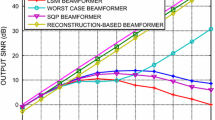Abstract
When the phase-mode transformation technique is used in a uniform circular array, its output performance is known to degrade owing to the approximations applied to the formulation. In this paper, we develop a robust recursive updating algorithm based on the worst-case performance optimization and phase-mode transformation in the uniform circular array, which provides efficient robustness not only against the signal steering vector mismatches, but also against the transformation errors. The proposed algorithm belongs to the class of the diagonal loading technique and the transformation matrix belongs to a certain ellipsoid set. The weight vector is updated by the Lagrange multiplier method, in which the parameters are derived simply. The proposed algorithm has a closed-form solution, in which we analyse the reasonable ranges of two key parameters. The convergence performance and the output SINR performance are also analysed. In additional, the implementation complexity costs of the proposed algorithm and MVDR algorithm are presented in this paper. Our robust algorithm has a low implementation complexity cost and achieves the mean output array SINR consistently close to the optimal one. Simulation results are presented to compare the performances of our algorithm with the conventional algorithms.






Similar content being viewed by others
References
A. Mohsen, K. Mahmood and A. Zakiyeh, Robust beamforming in circular arrays using phase-mode transformation, IET Signal Processing, Vol. 7, pp. 693–703, 2013.
M. Askar, and M. Karimi, Quadratically constrained beamforming applied to UCA. In Twentieth Iranian Conference on Electrical Engineering, Vol. 5, pp. 1178–1183 (2012).
A. B. Gershman, E. Nemeth and J. F. Bohme, Experimental performance of adaptive beamforming in a sonar environment with a towed array and moving interfering sources, IEEE Transactions on Signal Processing, Vol. 48, pp. 246–250, 2000.
W. Zhang, J. Wang and S. L. Wu, Adaptive multiple-input multiple-output radar beamforming based on direct data domain approach, IET Radar, Sonar & Navigation, Vol. 8, pp. 632–638, 2014.
J. Li and P. Stoica, Robust Adaptive Beamforming, WileyNew York, 2005.
A. E. A. Blomberg, A. Austeng, R. E. Hansen and S. A. V. Synnes, Improving sonar performance in shallow water using adaptive beamforming, IEEE Journal of Oceanic Engineering, Vol. 38, pp. 297–307, 2013.
X. Jiang, W. J. Zeng, A. Yasotharan, H. C. So and T. Kirubarajan, Robust beamforming by linear programming, IEEE Transactions Signal Processing, Vol. 62, pp. 1834–1849, 2014.
J. L. Yu and C. C. Yeh, Generalized eigenspace-based beamformers, IEEE Transaction on Signal Processing, Vol. 43, pp. 2453–2461, 1995.
J. Foutz, A. Spanias, S. Bellofiore and C. A. Balanis, Adaptive eigen-projection beamforming algorithms for 1D and 2D antenna arrays, IEEE Antennas and Wireless Propagation Letters, Vol. 2, pp. 62–65, 2003.
R. A. Monzingo and T. W. Miller, Introduction to Adaptive Arrays, WileyNew York, 1980.
L. Zhang, W. Liu and R. J. Langley, A class of constrained adaptive beamforming algorithms based on uniform linear arrays, IEEE Transactions on Signal Processing, Vol. 58, pp. 3916–3922, 2010.
B. D. Carlson, Covariance matrix estimation errors and diagonal loading in adaptive arrays, IEEE Transactions on Aerospace and Electronic Systems, Vol. 24, pp. 397–401, 1988.
S. J. Kim, A. Magnani, A. Mutapcic, S. P. Boyd and Z. Q. Luo, Robust beamforming via worst-case SINR maximization, IEEE Transactions on Signal Processing, Vol. 56, pp. 1539–1547, 2008.
S. A. Vorobyov, H. Chen and A. B. Gershman, On the relationship between robust minimum variance beamformers with probabilistic and worst-case distortionless response constraints, IEEE Transactions on Signal Processing, Vol. 56, pp. 5719–5724, 2008.
A. Khabbazibasmenj, S. A. Vorobyov and A. Hassanien, Robust adaptive beamforming based on steering vector estimation with as little as possible prior information, IEEE Transactions on Signal Processing, Vol. 60, pp. 2974–2987, 2012.
B. Liao, C. T. Guo, L. Huang, Q. Li and H. C. So, Robust adaptive beamforming with precise main beam control, IEEE Transactions on Aerospace and Electronic Systems, Vol. 53, pp. 345–356, 2017.
M. Rubsamen and A. B. Gershman, Robust adaptive beamforming using multidimensional covariance fitting, IEEE Transactions on Signal Processing, Vol. 60, pp. 740–753, 2012.
B. Liao, S. C. Chan and K. M. Tsui, Recursive steering vector estimation and adaptive beamforming under uncertainties, IEEE Transactions on Aerospace and Electronic Systems, Vol. 49, pp. 489–501, 2013.
L. C. Godara, Application of antenna arrays to mobile communication, Part Π: Beam-forming and direction-of-arrival considerations, Proceedings of the IEEE, Vol. 85, pp. 1213–1216, 1997.
S. A. Vorobyov, A. B. Gershman and Z. Q. Luo, Robust adaptive beamforming using worst-case performance optimization via Second-Order Cone programming. In IEEE International Conference on Acoustics, Speech, and Signal Processing, Vol. 3, pp. 2901–2904 (2002).
S. Shahbazpanahi, A. B. Gershman, Z. Q. Luo and K. M. Wong, Robust adaptive beamforming for general-rank signal models, IEEE Transactions Signal Processing, Vol. 51, pp. 2257–2269, 2003.
M. Wax and J. Sheinvald, Direction finding of coherent signals via spatial smoothing for uniform circular arrays, IEEE Transactions on Antennas and Propagation, Vol. 42, pp. 613–620, 1994.
A. Elnashar, Efficient implementation of robust adaptive beamforming based on worst-case performance optimization, IET Signal Processing, Vol. 2, pp. 381–393, 2008.
A. Elnashar, S. Elnoubi and H. Elmikati, Further study on robust adaptive beamforming with optimum diagonal loading, IEEE Transactions on Antennas and Propagation, Vol. 54, pp. 3647–3658, 2006.
S. Attallah and K. Abed-Meraim, Fast algorithms for subspace tracking, IEEE Transactions Signal Processing Letter, Vol. 8, pp. 203–206, 2006.
P. Stoica, J. Li, X. Zhu and J. R. Guerci, On using a priori knowledge in space-time adaptive processing, IEEE Transactions on Signal Processing, Vol. 56, pp. 2598–2602, 2008.
L. Du, J. Li and P. Stoica, Fully automatic computation of diagonal loading levels for robust adaptive beamforming, IEEE Journal & Magazines, Vol. 46, pp. 449–458, 2010.
Acknowledgements
The authors thank the anonymous reviewers for their insightful comments that helped improve the quality of this study. This work was supported by the National Nature Science Foundation of China under Grant no. 61473066 and no. 61601109, and the Fundamental Research Funds for the Central Universities under Grant No. N152305001.
Author information
Authors and Affiliations
Corresponding author
Additional information
Publisher's Note
Springer Nature remains neutral with regard to jurisdictional claims in published maps and institutional affiliations.
Appendix
Appendix
1.1 A. The Ellipsoid Set Covering \({\varvec{U}}\)
The first part of the array correlation matrix \({\varvec{U}}\) is given by
where the diagonal error matrix \(\Delta {\varvec{G}}\) and the matrix \({\varvec{Z}}\) are written in the following form for simplicity
where the each \(z_{i}\) must satisfy the inequation \(\left| {z_{i} } \right| \le \delta_{{i,\text{ }}} (i = - \nu , \ldots ,\nu )\).
The \(i{\text{th}}\) column of (65) is equal to
We consider the fact that the upper bound of \(z_{i}\) is the following inequation
It is shown that the vector \({\varvec{g}}_{1,i}\) belongs to the following ellipsoid set
where the parameter \(\varepsilon^{2}\) can be chosen as
The second part of the array correlation matrix is \({\varvec{U}}_{2} = \Delta {\varvec{G\hat{R}}}_{xx} {\varvec{G}}_{0}^{H}\), and we can write the \(i{\text{th}}\) column of the matrix \({\varvec{U}}_{2}\) as
We can conclude that the vector \({\varvec{g}}_{2,i}\) belongs to the ellipsoid set [1]
Similarly, we can conclude that the third part \({\varvec{U}}_{3} = {\varvec{G}}_{0}^{{}} {\hat{\varvec{R}}}_{xx} \Delta {\varvec{G}}^{H}\) belongs to the ellipsoid set
1.2 B. The Detailed Proof of (24)
Proof
For an arbitrary \({\varvec{w}}\), we can prove that
The inequality (74) is rewritten as
We can derive (75) as
where the vector \({\hat{\varvec{w}}}_{b} = \Delta {\varvec{G}}^{H} {\varvec{w}}\).
Considering (76) for Euclidean norm, it is easy that we can conclude the inequality
Therefore, the inequality (24) is true.
1.3 C. The Derivation of the Lagrange Multiplier \(l\)
The quadratic constraint of the optimization problem (28) is written as
where
Inserting (31) into (78), we can obtain the Lagrange multiplier \(l\) as
where
In (39), \({\varvec{q}}(k) = [{\varvec{I}} - u{\varvec{U}}]{\hat{\varvec{w}}}(k)\).
From the Eqs. (80) and (81), we note that the solving process of the parameter \(l\) is very complicated. To decrease the computation cost, we can simply compute \(l\) by the linear combination method. According to [26], we consider a linear combination with the form
where \({\hat{\varvec{U}}} = \left( {{\varvec{G}}_{0} + \Delta {\varvec{G}}} \right)\left( {\varvec{R}_{\varvec{N}} + r{\varvec{I}}} \right)\left( {{\varvec{G}}_{0} + \Delta {\varvec{G}}} \right)^{H}\), \(\gamma > 0\), and \(\eta > 0\).
Then, we can obtain the enhanced covariance matrix as
Contrasting the diagonal loading covariance matrix \({\hat{\varvec{U}}} + l\xi^{2} {\varvec{\rm I}}\) in (33) and \({\hat{\varvec{U}}} + \frac{\gamma }{\eta }{\varvec{\rm I}}\) in (83), we derive that the loading factor \(l\xi^{2}\) can be replaced by \({\gamma \mathord{\left/ {\vphantom {\gamma \eta }} \right. \kern-0pt} \eta }\). In this way, we can obtain the parameter \(l\) as
Contrasting (80) and (84), the proposed algorithm can decrease the complexity cost. Next, we must get the parameters \(\gamma\) and \(\eta\) by minimizing the mean squared error (MSE) of \({\hat{\varvec{U}}}_{d}\) as
The minimization problem is derived as [27]
By minimizing (86) with respect to \(\gamma\), we can obtain the optimal \(\gamma_{0}\) for fixed \(\eta\) as
Inserting \(\gamma_{0}\) into (86) and replacing \(\eta_{0}\) by \(\eta\), we give another unconstrained minimization problem
Computing the gradient of (88) and equating it to zero yields the optimal solution for \(\eta\) as
where \(\alpha = \frac{{\left\| {\varvec{U}} \right\|^{2} M - tr^{2} \left( {\varvec{U}} \right)}}{M},\quad \chi = E\left\{ {\left\| {{\hat{\varvec{U}}} - {\varvec{U}}} \right\|^{2} } \right\}\)
To estimate \(\gamma_{0}\) and \(\eta_{0}\) from the received available data, we need to obtain the estimation values for \(\chi\) and \(\alpha\). In practice, the exact array correlation matrix \({\varvec{U}}\) is unavailable. Therefore, \({\varvec{U}}\) is replaced by \({\hat{\varvec{U}}}\) to estimate \(\alpha\) as
Let \(\hat{r}_{m}\) and \(r_{m}\) denote the \(m{\text{th}}\) columns of \({\hat{\varvec{U}}}\) and \({\varvec{U}}\), respectively. We have
Alternatively, we can use the unbiased estimate \(\left\| {{\hat{\varvec{U}}} - {\varvec{U}}} \right\|^{2}\) for \(E\left\{ {\left\| {{\hat{\varvec{U}}} - {\varvec{U}}} \right\|^{2} } \right\}\).
Thereby, we can estimate \(\chi\) as [26]
Applying (90) and (92), we can derive the estimation values for \(\gamma_{0}\) and \(\eta_{0}\), respectively
and
Finally, the diagonal loading factor \(\lambda \xi^{2}\) is replaced by the estimation ratio \({{\hat{\gamma }_{0} } \mathord{\left/ {\vphantom {{\hat{\gamma }_{0} } {\hat{\eta }}}} \right. \kern-0pt} {\hat{\eta }}}_{0}\). Thus we can obtain the expression of the Lagrange multiplier \(l\) as
Rights and permissions
About this article
Cite this article
Song, X., Han, X., Wang, F. et al. Recursive Updating Algorithm for Robust Adaptive Beamforming in a Uniform Circular Array. Int J Wireless Inf Networks 26, 331–343 (2019). https://doi.org/10.1007/s10776-019-00449-4
Received:
Revised:
Accepted:
Published:
Issue Date:
DOI: https://doi.org/10.1007/s10776-019-00449-4




